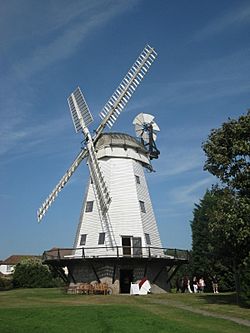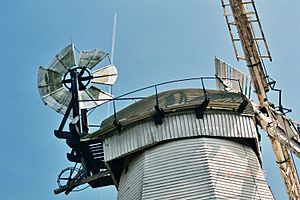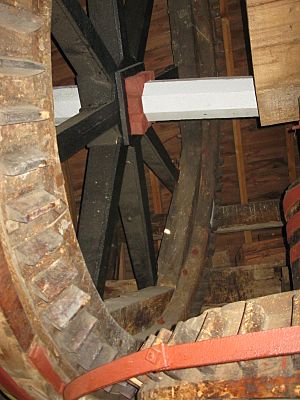Upminster Windmill facts for kids
Quick facts for kids Upminster Windmill |
|
|---|---|

The mill in September 2012.
|
|
| Origin | |
| Mill name | Abraham's Mill Upminster Mill |
| Grid reference | TQ 557 867 |
| Coordinates | 51°33′29″N 0°14′42″E / 51.558°N 0.2451°E |
| Operator(s) | Friends of Upminster Windmill |
| Year built | 1803 |
| Information | |
| Purpose | Corn mill |
| Type | Smock mill |
| Storeys | Four-storey smock |
| Base storeys | Single-storey base |
| Smock sides | Eight sides |
| No. of sails | Four sails |
| Type of sails | Patent sails |
| Windshaft | cast iron |
| Winding | Fantail |
| Fantail blades | Six blades |
| Auxiliary power | steam engine |
| No. of pairs of millstones | Four pairs |
| Size of millstones | Two pairs 4 feet 6 inches (1.37 m) diameter Two pairs 4 feet 0 inches (1.22 m) diameter. |
Upminster Windmill is a special old building called a smock mill. It's located in Upminster, which is part of London, England. This windmill used to be known as Abraham's Mill. It was built in the county of Essex.
Between 2016 and 2023, the windmill was carefully fixed up so it could work again. A new visitor center was also built. Now, you can visit the mill and the visitor center at certain times.
Contents
History of Upminster Windmill
There was a windmill in Upminster as early as 1768. The current mill was built in 1803 for James Nokes. It had four simple sails and could grind grain using three pairs of millstones.
In 1811, a steam engine was added to help the mill work. This engine could power two more pairs of millstones. This made the mill much more valuable. By 1849, the mill had five pairs of millstones. By 1856, it could use both wind and steam to power six pairs of millstones.
New Owners and Repairs
Thomas Abraham bought the mill in 1857. He had worked for the previous owner, James Nokes, at this mill and another one. In 1876, a main shaft inside the mill broke. It was fixed with a strong metal part.
After Thomas Abraham passed away in 1882, his nephew John Arkell Abraham took over. In 1889, lightning struck the mill. On January 5, 1900, the main shaft holding the sails snapped. The sails crashed to the ground! A new shaft from another windmill was put in, along with four new sails.
After John Arkell Abraham died, his nephews Thomas, Alfred, and Clement took over. In 1927, a large wooden beam (called a stock) was replaced. The fantail, which helps the mill face the wind, was also repaired.
End of Commercial Work and Preservation
The mill stopped grinding grain for money in 1934. It was bought by W. H. Simmonds for £3,400. The steam engine parts were sold off. The buildings around the mill fell apart and were eventually taken down.
Later, in the late 1930s, Essex County Council bought the mill. It was officially recognized as a special historic building in 1955.
On June 22, 2004, a group called the Upminster Windmill Preservation Trust took over the care of the mill. They signed a 35-year agreement. In 2007, strong winds damaged the mill's stock and a sail. Two new sails were put on in August 2008.
How the Windmill Works
Upminster Windmill is a "smock mill." It has a four-story wooden tower (the smock) sitting on a single-story brick base. There's a platform around the first floor. The top of the mill, called the cap, is shaped like a boat. It has a walkway around it. A six-bladed fantail helps turn the cap so the sails face the wind.
Four large sails, called Patent sails, are attached to a strong metal shaft. The mill uses wind power to turn four pairs of millstones. The whole mill is about 52 feet (16 meters) tall to the top of its cap.
The Base and Smock
The brick base of the mill is about 24 feet 9 inches (7.5 meters) wide. It stands about 9 feet 6 inches (2.9 meters) high. The brick walls are very thick at the bottom.
The wooden smock tower has four levels. It's built with strong wooden posts and beams.
Cap and Fantail
The boat-shaped cap is about 17 feet 6 inches (5.3 meters) long and 16 feet 10 inches (5.1 meters) wide. It's about 8 feet 9 inches (2.7 meters) high. The cap has an unusual walkway on the outside. The fantail has six wooden blades. It has the year 1799 carved on a beam underneath it.
Sails and Windshaft
The main shaft that holds the sails is made of cast iron. It was moved to Upminster in 1899 from another mill. This happened after the original shaft broke in a storm.
This shaft holds a large brake wheel, which is about 10 feet 4 inches (3.1 meters) across. This wheel has 78 cogs (teeth).
Originally, Upminster Windmill had simple canvas sails. But when it stopped working commercially, it had four "double patent sails." These sails were very large, about 70 feet (21 meters) wide. Each sail had many small wooden shutters that could be opened or closed to control the wind.
Inside Machinery
The main upright shaft inside the mill is made of wood. It's about 30 feet 4 inches (9.2 meters) long. This shaft connects the turning cap to the millstones below.
At the bottom of the upright shaft, a large wheel called the great spur wheel turns. It has 126 cogs. This wheel drives four pairs of millstones.
The millstones are used to grind grain into flour. There are three pairs of "French Burr" stones and one pair of "Peak" stones. Two pairs of stones are about 4 feet 6 inches (1.4 meters) wide. The other two pairs are about 4 feet (1.2 meters) wide.
The Steam Engine
A steam engine was once located in a brick building next to the windmill. This engine helped power two pairs of millstones and other machines. It could also lift sacks of grain.
The steam engine was removed in 1940. The building it was in was taken down in 1960. Two of the millstones from the steam engine are now at the windmill's entrance.
Millers of Upminster Windmill
- James Nokes (1803–1838)
- Thomas Nokes (1838–1849)
- Thomas Abraham (1857–1882)
- John Arkell Abraham (1882–1912)
- Thomas, Alfred and Clement Abraham (1912–1934)
Location of the Mill
The Upminster Windmill is located in a small open area called Windmill Field. This area is looked after by Havering Council. You can find it on St Mary's Lane.
The closest train stations are Upminster Bridge tube station and Upminster station. From the top of the windmill, you can see far-off places like Canary Wharf and the transmitter at Crystal Palace.





